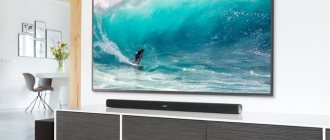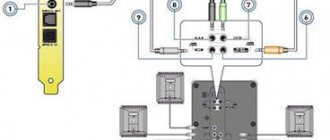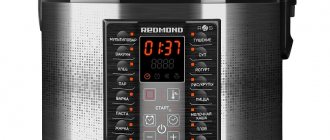Key features of Samsung soundbars
Keep in mind! Samsung soundbars have a lot of advantages:
- original technology significantly improves the sound of the TV ;
- speaker systems are as simple and straightforward to set up and control as possible ;
- Samsung soundbars on the market are presented in different modifications - 2.1, 3.1, 5.1, 7.1;
- many models are compact , they do not require a lot of free space for installation and use;
- For greater convenience, Samsung branded soundbars support connecting flash drives or mobile devices ;
- branded acoustics are multifunctional devices with support for many useful options - Wi-Fi, USB, etc .;
- The acoustic systems of this company have an attractive design, high build quality, and a wide range of products to suit any needs.
Note! Soundbars from Samsung are divided into several popular lines with their own features and advantages:
- Q-series. This is Surround Sound Expansion Plus technology with deep surround sound (like in a real cinema). 5.1-channel surround sound with amazing sound realism, over-the-air connectivity;
- interior S-series. Sound with excellent detail, clear and deep bass, the ability to wirelessly connect to a TV, support for HD Audio and streaming music services;
- classic soundbars. Excellent sound in any room, the function of expanding the surround sound area with excellent audibility to the right and left of the TV, over-the-air connection, powerful subwoofers, support for streaming audio.
Tips for choosing a speaker system
- Decide on the power range of the speaker system. There are complex formulas for calculating it, but it’s worth remembering one thing: if the speakers are too loud, you can always make them quieter, but vice versa, not. For a room measuring about 20 square meters. m. It is worth taking a closer look at models with a power of 35-50 W;
- Decide on the system format; if you will mainly watch clips and listen to music on the TV, then a 2.0 or 2.1 system will be perfect, but for watching movies or games, 5.1 or more will be better.
- You shouldn’t chase a brand; now there are products of good quality from little-known manufacturers on sale, you can listen to them in real stores and compare.
Video on how to choose a speaker system for your home
Rating-review of the best soundbars
The company produces a large range of high-quality soundbars with different technical characteristics.
Stay up to date! Below are the best Samsung speaker models with descriptions.
Let's look at the TOP 7 best Samsung soundbar models in terms of price and quality ratio.
Samsung HW-T650
The Samsung HW-T650 soundbar is equipped with an external subwoofer and a front speaker with main speakers and a built-in central speaker.
They provide balanced and high-quality reproduction of the entire frequency spectrum.
Bluetooth technology makes it possible to listen to audio tracks from a mobile device without using wires.
Settings are controlled and the volume level of the system and TV is adjusted using the included remote control.
The presented acoustics are compatible with TVs, USB drives, and game consoles.
Automatic sound optimization gives you complete immersion in the atmosphere of a movie or game.
Main characteristics:
- configuration - 3.1;
- output power (total) - 340 W;
- front emitter - 180 W, 980 × 58 × 90 mm, 2.4 kg;
- subwoofer - 160 W, 205 × 353 × 303 mm, 6.2 kg;
- connection - optical input, HDMI, Bluetooth;
- Features: remote control control.
Advantages
- stylish appearance;
- high build quality;
- wide range of interfaces;
- Convenient fastenings included.
Flaws
- lack of sound picture volume;
- large mass of the subwoofer;
- easily soiled body.
Samsung HW-T550
The Samsung HW-T550 model with support for DTS/Dolby Digital technologies, five powerful speakers and a set of up-to-date connection interfaces provides clear and surround sound for media content.
The front panel and subwoofer housings are made of particularly durable materials that are resistant to external negative factors.
With the help of the presented soundbar, the capabilities of the TV can be expanded to the level of a home theater.
The rear panel of the audio system is equipped with an HDMI connector and a USB port for connecting a sound source and an external storage device.
The included remote control allows you to change channels, adjust the volume, operate the equalizer, and more.
Main characteristics:
- configuration - 2.1;
- output power (total) - 320 W;
- front emitter - 160 W, 860 × 55 × 85 mm, 2.1 kg;
- subwoofer - 160 W, 200 × 353 × 290 mm, 5 kg;
- connection - optical input, HDMI, Bluetooth, USB-A;
- Features: Dolby Digital/DTS support, bass/treble adjustment, remote control control.
Advantages
- wide frequency range;
- current interfaces;
- informative display;
- It is possible to connect rear speakers.
Flaws
- not very clear instructions;
- the subwoofer speaker is not protected;
- When connecting via HDMI, you need to reboot the TV.
Samsung HW-T450
The Samsung HW-T450 kit with automatic detection of the sound source to optimize the quality of audio content is quite compact.
This allows you to install the speakers on a TV shelf or fix them on the wall using a bracket.
The presented system will surprise you with surround sound when watching movies and playing music tracks.
The device is equipped with a 200-watt remote subwoofer unit and a main panel with a declared audio range of 42-20000 Hz.
Bluetooth support allows you to transfer data from a tablet or smartphone.
A special game mode allows you to concentrate on gaming with complete immersion in the process.
Main characteristics:
- configuration - 2.1;
- output power (total) - 200 W;
- front emitter - 70 W, 860 × 54 × 74 mm, 1.5 kg;
- subwoofer - 130 W, 181 × 343 × 272 mm, 4.3 kg;
- connection - optical input, Bluetooth, USB-A;
- Features: Dolby Digital/DTS support, remote control.
Advantages
- high sound quality;
- excellent assembly and materials;
- support for modern decoders;
- relatively low price.
Flaws
- low power of the kit;
- insufficient volume effect.
Samsung HW-Q60T
The Samsung HW-Q60T uses the latest technology and computer modeling to deliver perfectly accurate and spacious sound.
The device supports the DTS Virtual X format with incredible audio depth.
The soundbar's speakers can sync with your TV's drivers to create an immersive sound experience.
A special analysis system optimizes the sound for a specific scene, making speech clear even at low volume levels.
Bluetooth wireless technology allows you to connect without cables getting in the way or getting tangled.
Main characteristics:
- configuration - 5.1;
- output power (total) - 360 W;
- front emitter - 200 W, 980 × 58 × 105 mm, 3.4 kg;
- subwoofer - 160 W, 205 × 353 × 303 mm, 6.2 kg;
- connection - optical input, HDMI, Bluetooth;
- Features: DTS Virtual X support, remote control.
Advantages
- The sound quality is excellent;
- automatic switching on when TV is activated;
- DTS Virtual X support;
- ability to customize sound.
Flaws
- when disconnected, it “forgets” the Bluetooth connection;
- small, inconvenient display;
- heavy weight of the subwoofer.
Samsung HW-Q6CT
The Samsung HW-Q6CT model with a classic body design is made in accordance with the most popular and sought-after 5.1 surround sound configuration.
The total sound power of the speaker system is 330 W.
This is enough for sounding medium and large rooms.
Dolby Digital technology provides surround sound.
The built-in USB port allows you to connect external drives to play audio files.
Bluetooth wireless technology allows you to stream audio tracks. Connection to TV can be done with an HDMI cable.
Main characteristics:
- configuration - 5.1;
- output power (total) - 330 W;
- front emitter - 200 W, 980 × 58 × 105 mm, 3.4 kg;
- subwoofer - 130 W, 205 × 353 × 303 mm, 4 kg;
- connection - optical input, HDMI, Bluetooth, USB-A;
- Features: Dolby Digital support, remote control.
Advantages
- excellent sound quality overall;
- connection via optical, HDMI and Bluetooth;
- support for surround sound technologies;
- affordable price tag.
Flaws
- relatively weak subwoofer;
- uninteresting design;
- Quite heavy front panel.
Samsung HW-T530
The Samsung HW-T530 soundbar, thanks to its front panel and remote subwoofer, allows you to get not only powerful sound with deep bass, but also enjoy an incredibly realistic surround effect.
The built-in Bluetooth module allows you to connect the soundbar to a TV, phone or tablet. A special system optimizes the sound stage, allowing you to get more intelligible voice accompaniment. Signal transmission is carried out via HDMI or S/PDIF. The USB port allows you to play audio files in OGG, MP3, AIFF formats , WAV, FLAC or AAC from a flash drive. The presented acoustics consume 53 W at maximum load.
Main characteristics:
- configuration - 2.1;
- output power (total) - 290 W;
- front emitter - 160 W, 860 × 55 × 85 mm, 2.1 kg;
- subwoofer - 130 W, 200 × 353 × 290 mm, 4.8 kg;
- connection - optical input, HDMI, Bluetooth, USB-A;
- Features: Dolby Digital support, remote control.
Advantages
- protection in the form of a metal mesh;
- wireless subwoofer connection;
- convenient adjustment of the frequency range;
- easy connection to TV;
- surround sound effect.
Flaws
- external power supply for the soundbar;
- sticker on top of the body;
- overpriced compared to analogues.
Samsung HW-Q950T
The Samsung HW-Q950T model with an integrated sound stage optimization mode will be an ideal solution for fans of films and TV series, music lovers and gamers.
The front panel and external rear speakers are easily mounted on the wall using a bracket.
Thanks to its compact size, an external subwoofer can be placed in the most suitable place in the room.
Multi-channel sound allows you to feel the effect of presence, and the presence of Bluetooth guarantees convenient connection of the system without wires.
This technology also allows connection to a tablet or smartphone.
Main characteristics:
- configuration - 9.1;
- output power (total) - 546 W;
- front emitter - 246 W, 1232 × 69.5 × 138 mm, 7.1 kg;
- rear speakers - 146 W, 120 × 210 × 141 mm, 2.1 kg;
- subwoofer - 160 W, 210 × 403 × 403 mm, 9.8 kg;
- connection - optical input, HDMI, Bluetooth;
- features - support for Dolby Digital/DTS/True HD, remote control, built-in Alexa assistant.
Advantages
- excellent sound overall;
- wide frequency range;
- luxurious surround sound;
- high quality build and materials.
Flaws
- Dolby Atmos only on demos;
- the acoustic fabric on the speakers collects dust;
- undemocratic price.
The process of connecting speakers to a TV
To connect stereo speakers to your TV, follow these steps in this order:
- Place the receiver or amplifier as close to the TV as possible, while remaining within reach of other devices (cable or satellite set-top box, DVD player, etc.);
- Ideally, the TV should be at a distance of 120-180 cm from the amplifier, otherwise a longer connecting cable will be required;
- Before connecting, make sure that all equipment is turned off;
- Find the analog or digital audio output on the TV (AUDIO OUT), this can be two RCA jacks or one 3.5 mm mini-jack, for digital audio there will be an optical output or an HDMI OUT port;
- Find a free audio input (AUDIO IN) on your stereo receiver (most likely the stereo or home theater input will be an RCA jack or an HDMI input port);
- Using a cable with matching plugs on each end, connect the TV's audio output to the receiver's audio input;
- Once all cables are connected, turn on your stereo amplifier and TV. But before you check the result, make sure that the volume on the receiver is at a low level. The sound from the TV should now come from the speakers.
All audio input (audio in) and audio output (audio out) connectors are always labeled, so they are easy to navigate. Below you can see a diagram of the main connectors:
Let's look at how to connect speakers to a TV via an RCA connection.
Look at the back of your TV, if there are red and white RCA jacks labeled “audio out”, then you can use a regular left and right stereo audio cable (tulip) to connect. We connect one end of the cable to the TV using the corresponding colors of the connectors, and the other to the speaker connector, where there is an inscription “Audio input”. If the device has several inputs, it is better to connect to the one marked “TV-IN”.
Some TVs may have a mini-jack (TRS 3.5 mm) instead of RCA audio output connectors. In this case, you can use a special RCA-TRS 3.5 mm cable, which can be easily found in stores.
Please note that the "jack" standard does not always mean that the signal will be received in a "stereo" format: if the plug has 2 contacts, then it is mono, and if there are 3 separations, then it is a stereo transmission.
It's important to note that on many new TVs, analog RCA or 3.5mm connections are no longer available. This means that if you're buying a new TV and your soundbar or audio system only has analog audio inputs, you'll need to make sure that the TV you're planning to buy actually has an analog audio output option. Otherwise, you may need to upgrade to a new soundbar or audio system that provides digital optical audio and/or HDMI-ARC connectivity options.
Depending on the model of the speaker system and the model of the TV, there may be the following connection options:
- The best option is to use fiber optic cable. It does not react to electromagnetic radiation, so the sound is delivered without the slightest interference or distortion. Connect the “optical out” cable on your set-top box to the “optical in” port on your cinema receiver, and you can enjoy deep, high-quality sound when watching any program;
- It is possible that your model of equipment has coaxial sockets; this is also an excellent option for pure transmission of multi-channel audio without the conversion procedure to an analog signal. The audio output connector on the TV will be called S/PDIF (Sony/Philips Digital Interface), or “out coaxial”, and on the cinema receiver “coaxial in”.
Home theater connection
The peculiarity of connecting a home theater is that the set of multimedia centers does not include wires for connecting additional devices, so you will have to purchase them yourself.
Look at the back of the center and find the video input jacks. Use the same method to determine the type of video output on your TV. Now you need to connect the two devices to each other, but before connecting, do not forget to disconnect them from the electrical network.
Most often, the connection between a TV and multimedia equipment is carried out either through linear connectors or SCART. After connecting, the speaker system is switched to “AUX” mode. If you did everything correctly, the sound from the TV should come from the speakers of the media center.
If you have made a connection and notice that the sound quality is poor or there is extraneous noise, the reason may be that the speaker volume setting is incorrect. Adjust the volume of the speakers by changing the settings on the TV and directly on the center itself.
However, there are many new TVs that do not have analog outputs (RCA or SCART), but instead have an HDMI port. For example, Samsung TVs without audio are very popular these days. This means that the audio output is built into the HDMI card on the device.
Of course, this can be intimidating if the user only has an RCA audio connection on their stereo receiver. But don’t worry, there is an option for this situation too.
HighDenition Multimedia Interface is an audio/video interface that is used to transmit audio and visual data. This is a flat port that you can see on TVs, audio systems and other devices. If both devices have HDMI ports, then there will be no connection problems: all you need to do is connect the TV to the audio system using an HDMI cable.
However, if your TV has HDMI and your audio system doesn't, you'll need a dedicated switch box. A typical HDMI 4x1 switcher has 3 to 4 different separate audio output options for connecting to your sound system:
- Digital coaxial;
- Digital optical;
- Analog RCA port (red and white jack).
All you have to do is select the port that your audio system supports. With this switch you can connect any receiver, external speakers, home theater or surround sound system. This solution will allow you to truly enjoy music or a movie, and gamers will especially like it.
Connecting a subwoofer
Speakers with a subwoofer for a TV are a relatively inexpensive solution for amplifying sound. Of course, the sound from a composite stereo system will be of higher quality, but a separate subwoofer can noticeably change the timbre of the sound and give a more decent sound level.
Low-frequency speakers operate in the range of approximately 20 to 160 Hz, and this is where the basis of sound transmission is created; with a subwoofer, the sound is fuller and deeper. Devices can be either active, that is, have an internal amplifier, or passive (without a receiver).
You can connect the active low-frequency speaker to the TV using the already familiar RCA cable: the “tulips” corresponding in color just need to be connected to the output jack on the TV body. All modern TV models have automatic settings, which makes connection easier. In the television menu, all that remains is to check the box in the “External playback devices” section.
Passive subwoofer models are not connected to the TV directly, but through an amplifier. That is, the speaker is connected to additional acoustic equipment:
- Connect the subwoofer to an external amplifier or home theater system;
- Carefully check the polarity of the connection: the speaker cable terminals are connected “+” to “+”, and “-” to “-”, right to right “R”, and left to left “L” output;
- The subwoofer outputs must be connected in parallel to the front speakers.
The connection must be organized in such a way that the speaker works together with the speaker system (home theater, computer). If you write it schematically, the connection of a passive subwoofer looks like this: subwoofer - speaker cable - amplifier - RCA cable - receiver.











